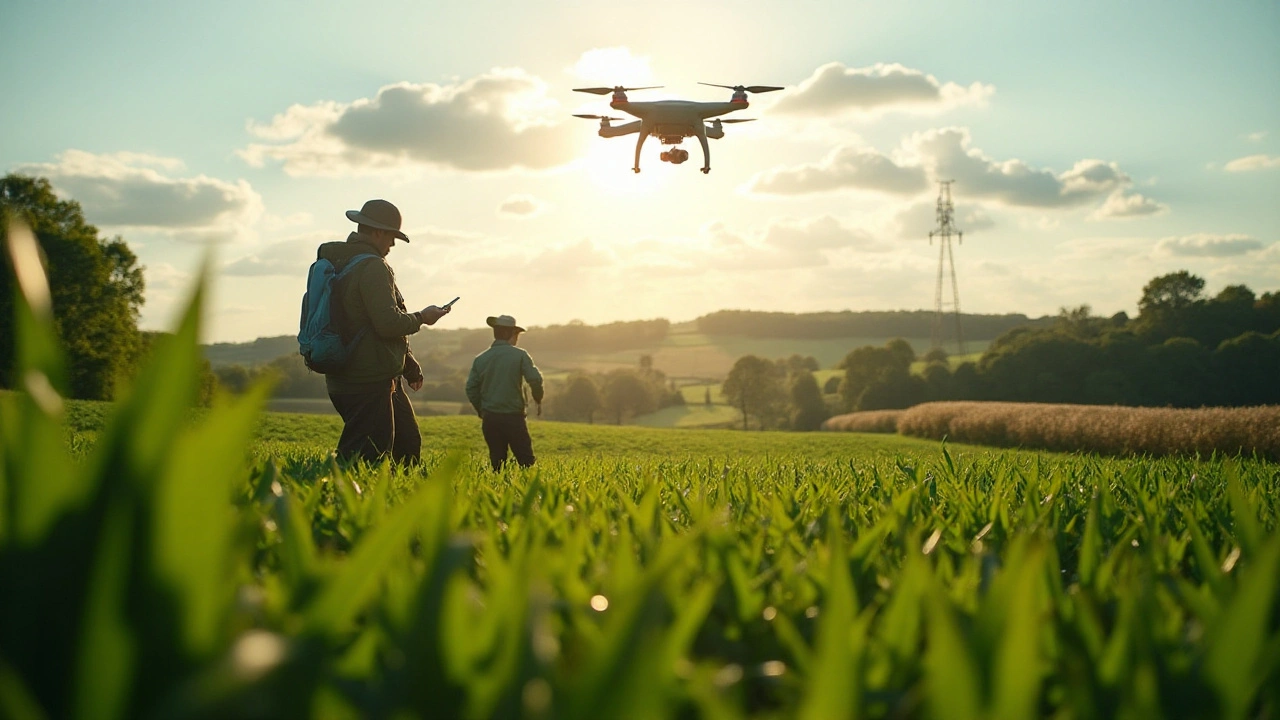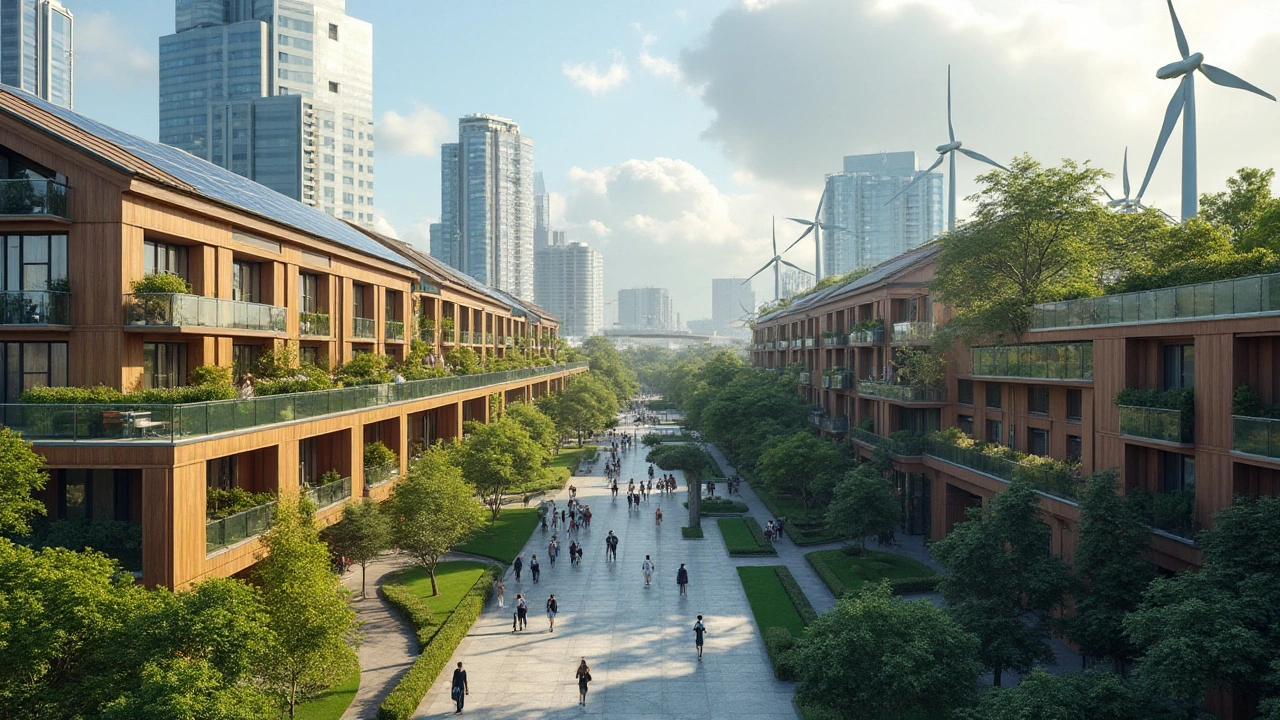Harnessing AI for a Greener Future: Sustainable Development Insights

In today's world, where the health of our planet is becoming increasingly critical, Artificial Intelligence (AI) stands out as a powerful tool capable of driving sustainable development. The application of AI in various sectors presents exciting opportunities to address environmental issues intelligently and efficiently.
AI is making waves in agriculture and energy management, offering smart solutions that range from optimizing water usage to predicting crop yields and ensuring energy efficiency. With its potential to enhance urban planning by paving the way for smart cities, AI is setting the stage for reshaping the way we interact with our environment.
From tackling climate change to reducing carbon footprints, AI is stepping in to guide us toward a more sustainable future. But this journey isn't just about technology—it's also about collaboration and innovative thinking, with humans and AI working hand-in-hand to preserve our world for future generations.
- AI in Agriculture
- Energy Efficiency Improvements
- Urban Planning and Smart Cities
- AI's Role in Climate Change
AI in Agriculture
In the vast and interconnected fields of modern agriculture, Artificial Intelligence is ushering in a new era of technological revolution. By leveraging the computing power of AI, farmers and agriculturists around the globe are witnessing a transformation in how they cultivate and manage their crops. Instead of relying solely on traditional farming practices, AI introduces advanced techniques that emphasize efficiency, sustainability, and productivity. For example, precision farming, an AI-driven approach, allows farmers to use data analytics for optimal planting, watering, and harvesting strategies. This level of detailed monitoring and control helps reduce water waste and the overuse of fertilizers, which can have detrimental impacts on the environment.
AI technology in agriculture doesn't stop at just monitoring; it also involves predictive analytics that helps in foreseeing crop diseases and pest invasions before they occur. Farmers, armed with this foresight, can take preventive measures to protect their crops, thereby reducing reliance on chemical treatments. The AI systems analyze various parameters like weather conditions, soil health, and crop pattern data to provide actionable insights. A 2020 report found that the adoption of AI technologies in agriculture could potentially boost farm productivity by up to 60%. Given the pressing need to feed a growing global population, such improvements are not only welcome but necessary.
"Artificial Intelligence in agriculture is not just about technology, it's about profound transformation," said a leading scientist from the Food and Agriculture Organization (FAO). "It offers the potential to fight hunger and food insecurity while safeguarding the environment."
Moreover, AI is playing a crucial role in automating monotonous tasks that are labor-intensive. Drones and autonomous tractors equipped with AI capabilities are revolutionizing how fields are plowed, seeds are sown, and crops are harvested. These innovations help farmers optimize their time and reduce labor costs, allowing them to focus on strategic activities that drive growth. Not only does this make agricultural operations more sustainable, but it also paves the way for smart farming practices that ensure the health of arable land and longevity of the farming industry.
Smart Farming Devices
The advent of smart farming devices and applications further enriches the agricultural landscape. These devices collect and transmit real-time data about crop growth and environmental conditions, effectively creating an Internet of Things (IoT) network for the farms. The data gathered is analyzed by AI algorithms, which offer suggestions and even make adjustments to farming equipment autonomously. An example of these advanced tools are sensors that detect soil moisture levels, allowing farmers to mechanize their irrigation systems only when necessary. This intelligent use of resources conserves water, a critical asset, particularly in areas prone to drought.
As we look to the future of farming, the role of AI isn't just to digitize traditional practices; it's about integrating knowledge, Information, and technology to create smarter, efficient, and more sustainable farming ecosystems. It's clear that the seamless blend of traditional wisdom and modern technology will define and shape agriculture in the years to come.

Energy Efficiency Improvements
The wave of energy transformation is sweeping through industries, homes, and cities, thanks in no small part to the advancements in Artificial Intelligence. AI has the power to identify areas where energy is being wasted and optimize usage. This is directly influencing how energy is consumed, leading to both cost savings and a reduction in carbon emissions. One of the areas where this impact is felt most dramatically is in smart grids. These grids use AI-driven algorithms to predict electricity demand and adjust the generation and distribution of energy accordingly. Not only does it reduce waste, but it also prevents outages, making our energy systems more robust.
AI-enhanced energy management systems are being adopted in various sectors, from commercial buildings to manufacturing. These systems use predictive analytics to anticipate the energy needs of facilities, enabling them to adjust heating, cooling, and lighting settings without human intervention. It's an intricate dance of data processing that results in tangible benefits in energy consumption reduction. In many cases, AI-powered solutions have been able to drop energy usage by over 30% in large facilities, highlighting immense potential for broader application.
Case studies show prophetic results. For instance, some of the world's largest tech companies utilize AI to manage their sprawling data centers. These data centers are notorious for their energy consumption. By meticulously analyzing a plethora of data points—from ambient temperature to equipment load—AI creates an ideal environment that reduces electricity usage but doesn't compromise performance.
According to a report by the International Energy Agency, "digital technologies, such as artificial intelligence, can save an estimated 5.7 TWh of electricity by 2030."This staggering figure underscores why the implementation of AI in energy conservation is not just beneficial but necessary. More cities are inclining towards AI solutions like intelligent street lighting that adjusts brightness based on the amount of traffic or time of night, while sensors and AI can predict usage patterns in residential communities to further cut waste.
On a smaller scale, AI is integrated into many of the thermostats and home automation systems that people use daily. These systems learn user habits and adjust the energy consumption of a home based on presence and preference, providing comfort and energy efficiency hand-in-hand. This singular focus on smart consumption is empowering individuals with both control and cost-efficiency. Sustainable Development relies heavily on these advancements, and as the technology matures, its potential is set to expand, bringing smarter and greener energy practices into everyday living.

Urban Planning and Smart Cities
As the world races toward a future where more than two-thirds of the population will live in urban areas, the concept of smart cities is emerging not just as a trend, but a necessity. At the heart of this transformation is Artificial Intelligence (AI), which offers a suite of tools that can significantly enhance urban planning. By integrating AI technologies, cities can become more efficient, sustainable, and livable. Imagine a city where traffic congestion becomes a thing of the past thanks to AI-powered traffic management systems that optimize the flow of vehicles in real-time. These systems can analyze data from cameras, sensors, and GPS devices to predict traffic patterns and adjust signals accordingly.
AI technology can also play a pivotal role in smart city initiatives such as waste management, energy use, and public safety. For instance, AI-driven waste collection systems utilize sensors to monitor bin levels and determine the most efficient routes for collection trucks, effectively reducing emissions and fuel consumption. In the realm of energy conservation, AI optimizes energy grids by predicting demand and adjusting supply, ensuring minimal waste. A compelling example is how some cities use AI to regulate street lighting, which can dim during low traffic times to save energy.
According to the United Nations, "Smart cities powered by AI can help slash carbon emissions and waste by up to 30%."
Public safety is another domain where AI is making substantial impact. With the help of AI-powered surveillance systems, authorities can enhance security measures without compromising privacy. These systems can instantly identify unusual patterns or behaviors and alert the relevant personnel, thus preventing potential incidents before they escalate. Moreover, AI aids in emergency response by predicting where natural disasters might hit hardest and advising on the best evacuation routes, which can save lives.
Data collected across the city, transformed into actionable insights, plays a critical role. AI algorithms analyze these datasets to present city planners with detailed models and scenarios, enabling them to make data-driven decisions. However, the integration of AI into urban infrastructures is not without challenges. Issues such as data privacy, cybersecurity, and technological disparities need careful consideration. Smart city projects must involve transparent governance models and actively engage citizens to foster trust and collaboration.
AI's role in shaping the future of urban living is pivotal, and the potential benefits it offers can revolutionize the way we think about cities. As cities adopt these technologies, they pave the way not only for increased technological sophistication but also for sustainable, inclusive growth. It is this synergy between technology and thoughtful planning that will set the course for making cities not just smart, but wisely governed and deeply human-focused.

AI's Role in Climate Change
Artificial Intelligence is playing an increasingly crucial role in the fight against climate change. By leveraging vast amounts of data and processing it efficiently, AI technology is helping researchers and policymakers understand the planet's changing climate with unprecedented accuracy. This understanding is critical because it allows for more informed and effective decision-making in environmental policy and intervention strategies. AI is not only offering insight but actively participating in creating solutions to mitigate climate impacts.
One of the significant ways AI contributes is through climate modeling. Climate models have traditionally relied on complex equations to simulate physical processes, which can be computationally expensive and time-consuming. AI-driven models, in contrast, can process large datasets quickly and improve the precision of climate predictions. By applying machine learning algorithms, these models can better predict weather patterns and extreme events, such as hurricanes and floods, allowing communities to prepare more effectively.
In addition to weather prediction, AI is being harnessed to optimize renewable energy production. Solar and wind energy, being inherently variable, require smart management to align energy supply and demand effectively. AI algorithms analyze weather forecasts and energy consumption patterns to optimize energy storage and grid distribution. This not only maximizes the efficiency of renewable resources but also reduces reliance on fossil fuels, thereby decreasing carbon emissions. It's a testament to how technology is driving the transition to green technology.
Moreover, AI's involvement in climate change isn't just technical; it's also about real-world applications. Start-ups and large companies alike are developing AI tools to monitor carbon emissions and track biodiversity loss. These systems use a combination of satellite imagery and machine learning to provide real-time data on emission levels and identify areas where intervention is needed. Such advancements offer innovative ways to hold industries accountable and support international commitments to reduce greenhouse gases.
"AI has the potential to accelerate global efforts to protect the environment and conserve resources by providing powerful tools for prediction, analysis, and optimization," said renowned environmental scientist Dr. Jane Goodall in a recent interview.
Moreover, AI's potential extends to more novel applications, such as enhancing carbon capture technology. Machine learning models can optimize the chemical processes involved in capturing atmospheric CO2, making them more efficient and cost-effective. This technology is crucial as it has the potential to remove enormous amounts of greenhouse gases from the air, effectively reversing some of the damage already done.
The combination of AI and environmental science offers a powerful weapon against climate change. By continuously improving models and systems that monitor and adapt to the Earth's changing environment, we are better equipped to face the challenges ahead. As AI technology advances, it promises to deliver even more significant breakthroughs in our quest to create a sustainable future. The potential is immense, yet it requires collective action and a shared commitment to harness these tools responsibly and equitably.